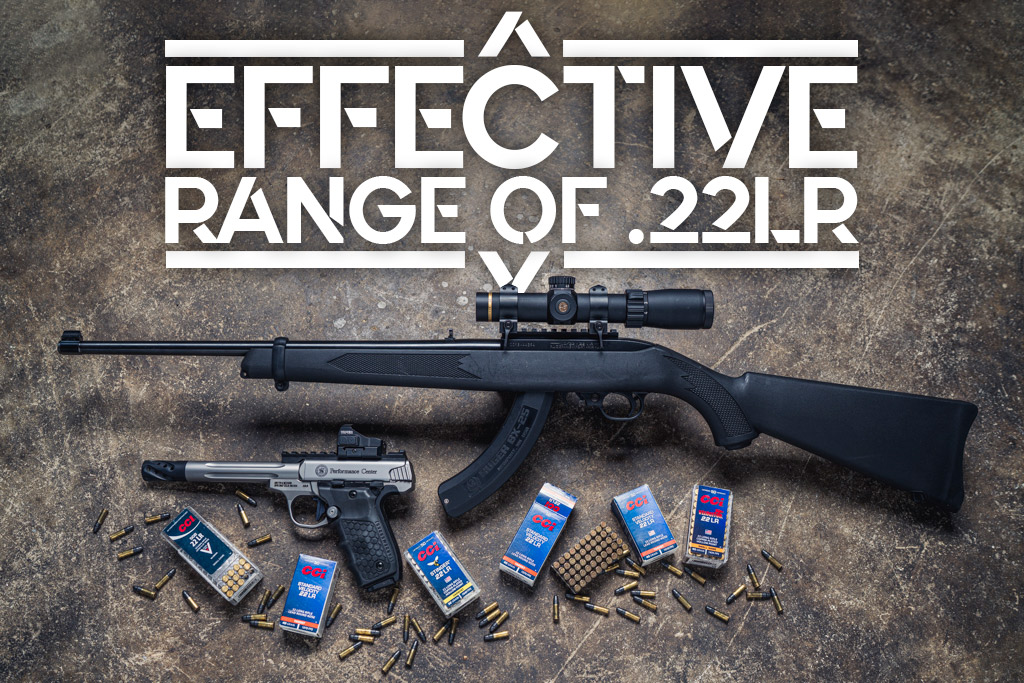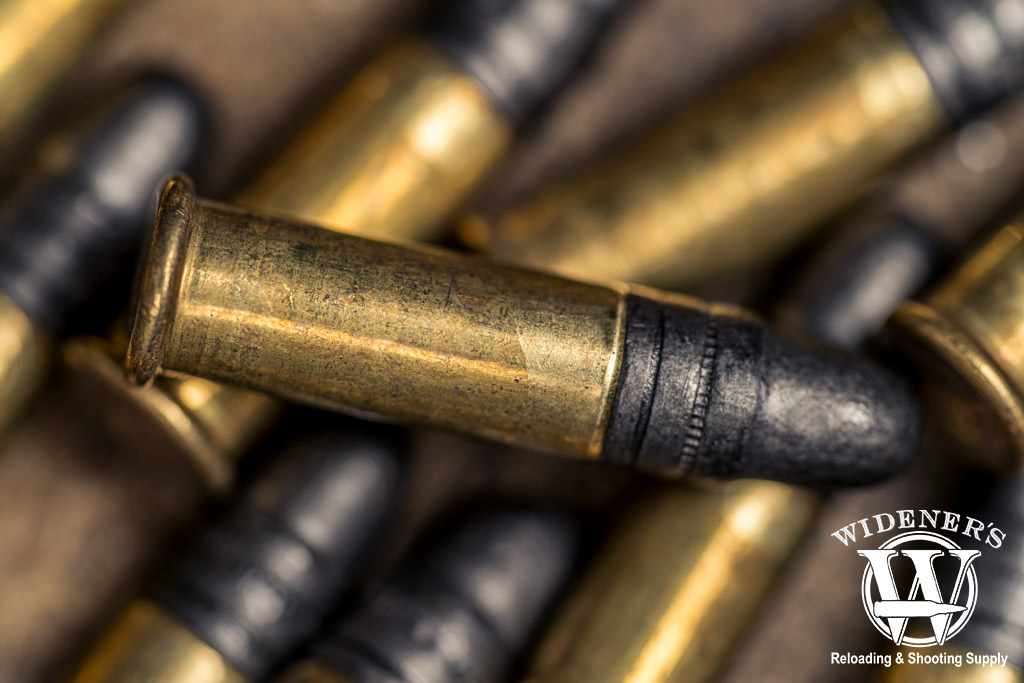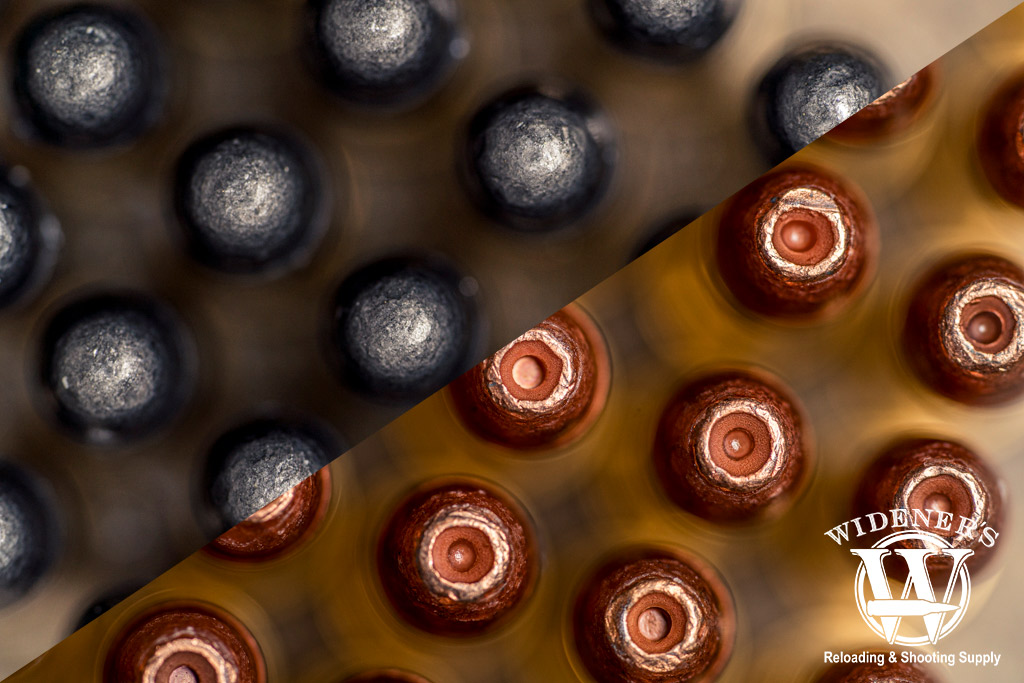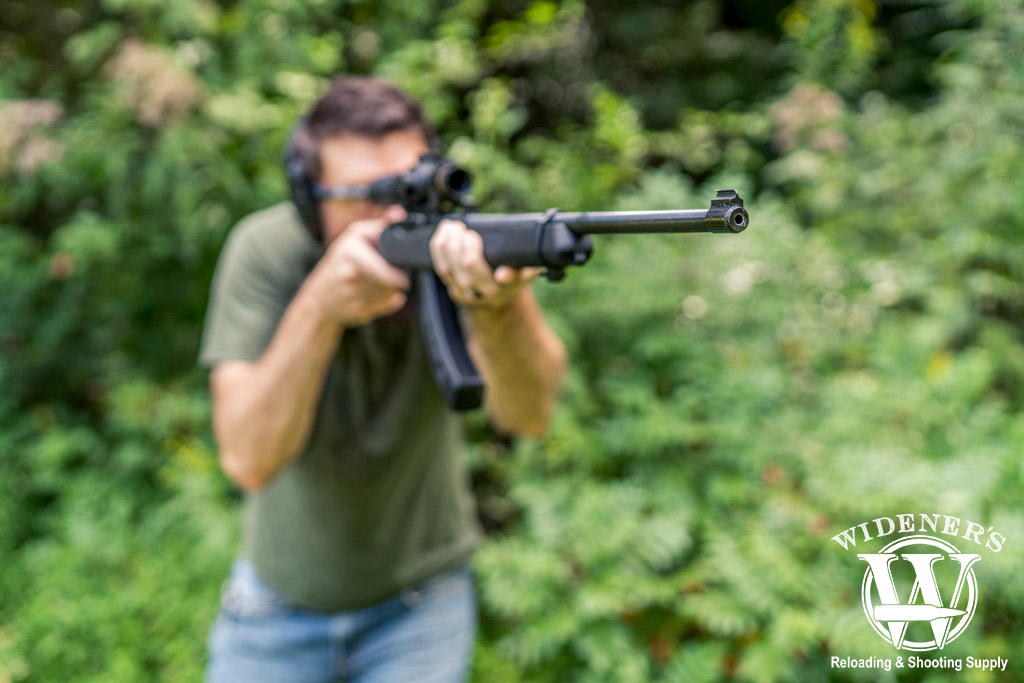

What exactly is the effective range of the .22LR cartridge? For most rifles with standard FMJ ammo, you can expect consistency out to 100-150 yards. However, ballistically speaking, there’s more to the story. That’s what we aim to break down for you with this rimfire guide.
If you’re a frequent shooter of any type, whether a casual target shooter or a master marksman training for a competition, odds are you’ve used .22 LR ammo. .22 LR cartridges are common and popular for their ease-of-use, low recoil, and general effectiveness. They’re recognized worldwide, from backyard plinking all the way to the Olympics.
.22 LR Specs & History

Since its introduction in 1887, the .22LR has remained one of the world’s most popular calibers.
The .22 LR or long rifle cartridge is one of the most common and long-running cartridges in the world. As a type of rimfire ammunition (ammunition with its primer burrowed inside a hollow circumferential rim that protrudes from the casing base), it’s incredibly versatile and can be used for rifles, revolvers, semi-auto pistols, shotguns, and even submachine guns!
| Cartridge Specs | .22LR |
|---|---|
| Parent Casing | .22 Long |
| Bullet Diameter | .223″-225″ |
| Neck Diameter | .226″ |
| Base Diameter | .226″ |
| Case Length | .613″ |
| Overall Length | 1.0″ |
| Grain Weight | 29gr-60gr |
| Max Pressure (SAMMI) | 24,000 PSI |
Famed manufacturer, J. Stevens Arms & Tool, brought the .22LR cartridge to the market in 1887. At the time of its introduction, it was loaded with black powder. It was later updated with modern smokeless powder, increasing its powder charge and efficiency. To date, it remains one of the most popular cartridges in the world.
Despite its ubiquity, many people don’t actually know the effective range of .22LR cartridges. Why? Because it differs depending on a variety of factors.
.22 LR Velocity

Bullet type makes a difference in performance, the LRN (top left), and the CPHP (bottom right).
Take a look, it’s in a book. According to Geoffrey Kolbe’s “Ballistics Handbook” (a 2000-published guide with accurate data regarding the ballistics information and velocities of many common cartridges), the .22 LR cartridge has an average muzzle velocity of about 1,075 FPS. This is significantly lower than subsonic speed, although certain .22 LR cartridges can easily reach velocities of 1,200 FPS, or greater.
| Caliber | Bullet Type | Bullet Weight | Velocity (Muzzle) | Energy (Muzzle) | 50 Yards (Velocity/Energy) | 100 Yards (Velocity/Energy) | 150 Yards (Velocity/Energy) |
|---|---|---|---|---|---|---|---|
| .22LR | LRN | 40gr | 1,240 FPS | 137 FT LBS | 1,103 FPS/108 FT LBS | 1,011 FPS/91 FT LBS | 944 FPS/79 FT LBS |
| .22LR | CPHP | 32gr | 1,640 FPS | 191 FT LBS | 1,292 FPS/119 FT LBS | 1,066 FPS/81 FT LBS | 940 FPS/63 FT LBS |
| .22LR | LSP (SubSonic) | 60gr | 950 FPS | 120 FT LBS | 899 FPS, 108 FT LBS | 848 FPS/96 FT LBS | 742 FPS/73 FT LBS |
Performance Compared
The .22 LR cartridge maintains its velocity quite well over distance. For example, the standard 40gr LRN bullet loses less than 300 FPS in velocity by the time it reaches the 150-yard mark. At 150-yards it sheds 42% of its energy and drops by 11.2″ at the same distance.
Proving that the .22LR is capable of high speeds, the 32gr CPHP can reach muzzle velocities of 1,640 FPS. This light-weight round stays well above the 900 FPS out to the 150-yard mark with an energy of 63 FT LBS. It drops about 10.8″ by the time it reaches 150-yards.
In comparison, the subsonic 60gr LSP round leaves the barrel at .45 ACP speeds. Intended to be shot suppressed, this round chugs downrange retaining 73 FT LBS of energy at the 150-yard mark. Expect a 18″ plus bullet drop by the time it reaches that distance.
All that to say, the effective range of .22LR shows that it is efficient and versatile. The above chart shows that it maintains good ballistic performance and accuracy at reasonable distances when fired from a rifle-length barrel.
So, How Far Can You Shoot With It?

Effective Range Of .22LR: It goes further than you might think, with some restrictions due to physics.
Although many shooters believe the .22 LR cartridge to be not suitable for long-distance hunting or target shooting, you might be surprised at the performance you can eke out of this cartridge under the right circumstances. Keep in mind, that ammo quality and barrel length are factors.
At 100 yards, the .22 LR cartridge can produce shot groups of better than one MOA (very tight groups) with a good 16″ barrel and ammo. It can consistently shoot a one MOA grouping out to 150-200 yards with match-grade ammo and the rifle secured on a rest.
To Infinity & Beyond?
Once you get to 300 yards or further, shot groups start to break apart. 1.5-2 MOA groups can be expected at the 300-yard range, while 3-MOA groups are more likely at the 400-yard range, and beyond. Once you hit 500 yards, 4-MOA patterns occur. The .22 LR cartridge struggles against wind deflections and vertical dispersion patterns.
Things diminish further once you try to use the .22 LR cartridge at 600 yards or beyond. You can hit a 13-inch target at 600-yards with a good optic if you have enough experience with the cartridge and your rifle. However, don’t expect consistency, as you are dropping the bullet in at that distance. With patience, you might be able to hit center mass 1/25 or so tries.
All in all, the effective range of the .22LR for stationary targets is about 300-400 yards, assuming good wind conditions and excellent marksmanship. While you may be able to hit targets beyond 400 yards, do not expect that your shots will be consistent. If you’re hunting critters or varmints, you’ll want to take them while the bullet still has some energy left in it. Your best bet is to stay in the 100-150 yard range for hunting.
.22 LR Ballistics
I decided to take a look at the ballistics from both rifle and pistol-length barrels. That way we’d have some real-world data to compare cartridge performance. The two available gun options are a Ruger 10-22 with a 16.12″ barrel, and a Smith & Wesson Victory with a 5.5″ barrel.
Both guns have optics that are zeroed at 50-yards, respectively. The ammo used in the testing is CCI Standard Velocity .22LR LRN 40gr, and Federal .22LR CPHP 36gr. Below, I recorded a good sample size of data (using a chronograph) for what to expect when using popular off-the-shelf rimfire guns and ammo.
Pistol Ballistics

The recorded pistol velocities (at the muzzle) aren’t that far off from the recorded rifle velocities.
Hitting steel targets handheld at 100-yards with the Smith & Wesson Victory pistol is challenging. The Vortex Viper red dot mounted on top made it easier to stay on target, however, I only managed to hit 5/10 at that distance with the 36gr CPHP ammo. Natural movement plays a lot into accuracy and without anything to brace against, my groupings were spread across the target.
At 150-yards the challenge increased. The large 6MOA dot on the Vortex covered half of the 24″ plate from that distance. On the first attempt, I only managed to get 2/10 shots on target. On the second attempt, I figured out the holdover for the dot and managed to hit 4/10 while controlling my breathing and squeezing the trigger slowly.
There are no markings on the Vortex optic, but if I had to guess, I was holding the dot about 16-18″ above the top of the target at 150-yards to ring steel. I’m sure I could hit the target at 200-yards with the pistol, however at that distance (or beyond) the velocities from the pistol barrel are underwhelming. You are much better off swapping to a rifle if you need the rimfire bullet to have any effectiveness.
Rifle Ballistics

You get a boost in velocity with a rifle-length barrel, making it the best option for targets at a distance.
Using the Ruger 10-22 with the Leupold VX-Freedom 1.5-4×20 mounted feels like cheating. Even at 100-yards at the lowest power. I was able to hit steel targets handheld with the 36gr ammo at 9/10 attempts, only missing on the first shot with an incorrect holdover. It’s easier to hold a rifle more securely than a pistol, and the increased barrel length helps with accuracy.
At 150-yards things get more challenging, I managed to hit 7/10 at that distance. I found the holdover to be about 10-12″ above the target for the 36gr ammo. Moving back to 200-yards, the steel targets are still within range of the rifle with the optic. However, the velocity begins to dip, and the bullet drop becomes more extreme. If you’re planning on hitting targets at those distances with .22LR, they better be stationary.
What Affects .22 LR Accuracy?
Due to its low grain weight and energy, the .22 LR cartridge can be affected by a variety of factors. For example, wind deflection can significantly alter a bullet’s path and affect end accuracy, even if the shooter has a lot of skill with their weapon and the cartridge.
Aside from wind deflection and user skill, elevation, and consistent bullet drop (due to gravity) can affect the .22 LR’s accuracy more than other factors.
Elevation & Bullet Drop
Experienced shooters will find that aerodynamic drag has a considerable effect on a .22LR’s bullet flight path. It’s a reason often cited in online discussions for why the .22LR is not the most optimal long-range round.
Once a .22 LR round has left the barrel, it’ll start to decelerate such that it loses 25% of its muzzle velocity before it reaches 250 yards away. Thus, you’ll need more elevation to hit more distant targets to account for the air friction and the gravity drop the bullet will experience.
For example, assuming average sea-level atmospheric pressure and regular temperatures, you’ll need to increase your angle of elevation if you want to hit a target 100 yards away. As you can see, the above manufacturer range estimates might perform well in a vacuum, but shooters rarely get the chance to take shots in outer space!
Real World Accuracy
So, bottom line: just how accurate is the .22 LR cartridge?
If you’re plinking in the backyard, the .22LR is as accurate, if not more so, than any other comparable cartridge. There’s a reason many gun manufacturers create drop-in barrel systems, or clones of their larger caliber handguns chambered in .22LR. It’s a great round for training, that’s cost-effective, and is a lot of fun to shoot.
When it comes to hunting, you’ll want to find a round that performs well in your pistol or rifle. I prefer to do my squirrel hunting with the Smith & Wesson Victory pistol, and I’ve found that it runs the 36gr CCI mini-mags very efficiently. With a red dot attached, I can drop bushy tails out to around 50-yards cleanly in the pine-heavy forests in our area.
Carrying a rifle will extend your range, as well as, give you a boost in velocity. My old beater Winchester Model 72 has an ancient Bushnell scope someone machined to the top of it. I can only get it to hold zero at 50-yards with 40gr ammo, so I run Federal Hunter Match HPs in it. With that setup, it’s more than accurate at 100-yards, and capable of eliminating varmints around the property line.
The .22 LR cartridge is good for target shooting, short-range hunting, and rimfire-caliber shooting competitions. But it certainly won’t replace your true long-distance cartridges or serious hunting ammo when you need to guarantee pinpoint accuracy and stopping power in the wild.
Effective Range Of .22LR

Barrel length, bullet type, and environmental factors all contribute to the effective range of .22LR.
If you want to buy or build a quality precision rifle chambered in .22LR, expect to budget for at least $800. Of course, you’ll need to add a quality optic to that budget as well. Thankfully the ammo is still cost-effective. Even match grade .22LR ammo comes in at about half the cost of larger centerfire calibers.
CCI Stingers are 32-grain and copper-plated hollow point .22 LR cartridges. They’re some of the best hunting ammunition you can get for this cartridge type, featuring lengthened casings (that may, nonetheless, exclude certain older rifles from being able to use them). They’re great choices for small-game hunting.
Or consider the Eley High-Velocity Hollow Points: 38-grain lead hollow point cartridges that can reach up to 1250 FPS. These are great if you want to maximize the range of your .22 LR rifle, as the faster speed will minimize the effect of drag on the cartridge as it goes down the range or reaches your target.
The extra velocity from modern cartridges does make a difference, even if the bullet is as small as .22LR. The less the bullet drops, the more accurate it is at distances. Selecting the right ammo can mean the difference between ringing steel, or spending an afternoon making guesses at range estimation. Knowing the limitations of a caliber and how to work within them is an important part of improving your accuracy.


